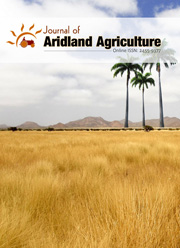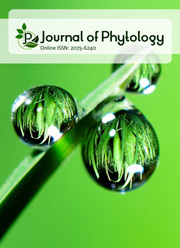Characteristics of soil physical properties based on soil profile depth in forest stands and upland farms in Andisols
DOI:
https://doi.org/10.25081/jaa.2025.v11.8870Keywords:
Soil physical properties, Forest stands, Upland farms, Soil profile depthAbstract
Information on the effect of forest stands and upland farms on soil physical properties is important for soil management. This study evaluated the effect of forest stands and upland farms on the physical properties of Andisols soils in the Mount-Merbabu National Park, Indonesia. A total of 108 soil samples were collected from each Pine, Acacia, Puspa (Schima noronhae Theaceae), Bintamin (Cupressus sp.), mixed, and upland farms at soil depths of 0-10, 10-20, 20-30, 30-50, 50-70 and 70-100 cm with three replications at each depth. The results showed that the sand fraction was in the range of 40.7%-73.8%, the silt fraction was in the range of 21.2%-42.6%, and the clay fraction was in the range of 3.2%-9.9%. Soil permeability shows that the value decreases with soil depth and shows different rates between forest stands and upland farms. The highest permeability in forest stands is found in Puspa stands 0-10 cm depth (7.50 cm h-1) and 20-30 cm depth (14.36 cm h-1) in the upland farms, the lowest rate is found in Pine stands 70-100 cm depth (3.07 cm h-1) and 70-100 cm (1.23 cm h-1) in the upland farms. Porosity shows a decreasing value with soil depth where the highest porosity is found in mixed stands at a depth of 10-20 cm (66.17%) and the lowest porosity in Puspa stands at a depth of 70-100 cm (44.41%). Upland farms shows a higher sand fraction content (0-100 cm depth) than forest stands, and forest stands show a higher silt fraction content (0-100 cm depth). Puspa stands have higher permeability than other forest stands (0-10 cm depth).
Downloads
References
Almendro-Candel, M. B., Lucas, I. G., Navarro-Pedreño, J., & Zorpas, A. A. (2018). Physical properties of soils affected by the use of agricultural waste. In A. Aladjadjiyan (Ed.), Agricultural Waste and Residues London, UK: IntechOpen Limited. https://doi.org/10.5772/intechopen.77993
Apriani, I., Arabia, T., & Sufardi, S. (2019). Identification of soil minerals using X-ray diffraction on Inceptisol Aceh Besar. Scientific Journal of Agricultural Students, 4(3), 155-163.
Arnalds, O. (2013). The influence of volcanic tephra (ash) on ecosystems. Advances in Agronomy, 121, 331-380. https://doi.org/10.1016/B978-0-12-407685-3.00006-2
Bisai, D., Chatterjee, S., & Tamili, D. K. (2016). Analysis of physical properties of soil samples in traditional agricultural area in Purba Medinipur District, West Bengal, India. International Journal of Innovative Science, Engineering & Technology, 3(4), 36-41.
Bouyoucos, G. J. (1962). Hydrometer method improved for making particle size analysis of soils. Agronomy Journal, 54(5), 464-465. https://doi.org/10.2134/agronj1962.00021962005400050028x
BPS-Statistics Indonesia. (2021). Regional statistics of Selo District 2021. Boyolali, Indonesia: BPS-Statistics Indonesia.
Febria, R., Rija, S., & Maya, D. (2014). Influence of land use and grading on various slopes on layer a thickness, porosity and permeability in Cikumutuk sub watershed of upper Cimanuk District, Garut Regency. Soilrens, 12(1), 30-34.
Harcourt, N., & Awatere, S. (2022). Rapua ngā tohu (seeking the signs)—Indigenous knowledge-informed climate adaptation. Current Directions in Water Scarcity Research, 4, 267-297. https://doi.org/10.1016/B978-0-12-824538-5.00014-5
Hatten, J., & Liles, G. (2019). A ‘healthy’ balance – The role of physical and chemical properties in maintaining forest soil function in a changing world. Developments in Soil Science, 36, 373-396. https://doi.org/10.1016/B978-0-444-63998-1.00015-X
Hattori, T. (1988). Soil aggregates as microhabitats of microorganisms. Reports of the Institute for Agricultural Research, Tohoku University, 37, 23-36.
Herawati, A., Mujiyo, M., Dewi, W. S., Syamsiyah, J., & Romadhon, M. R. (2024). Improving microbial properties in Psamments with mycorrhizal fungi, amendments, and fertilizer. Eurasian Journal of Soil Science, 13(1), 59-69. https://doi.org/10.18393/ejss.1396572
Indoria, A. K., Sharma, K. L., & Reddy, K. S. (2020). Hydraulic properties of soil under warming climate. Climate Change and Soil Interactions, 2020, 473-508. https://doi.org/10.1016/B978-0-12-818032-7.00018-7
Injiliana, L., Widiastuti, T., & Riyono, J. N. (2020). Erodibility (K) at various covers in the Village Baru Silat Hilir District, Kapuas Hulu Regency. Sustainable Forest Journal, 8(4), 773-781. https://doi.org/10.26418/jhl.v8i4.44323
Jaramillo, D. F. J. (2014). El suelo: origen, propiedades, espacialidad. Medellín, Colombia: Universidad Nacional de Colombia.
Jat, M. L., Bijay-Singh, Stirling, C. M., Jat, H. S., Tetarwal, J. P., Jat, R. K., Singh, R., Lopez-Ridaura, S., & Shirsath, P. B. (2018). Soil processes and wheat cropping under emerging climate change scenarios in South Asia. Advances in Agronomy, 148, 111-171. https://doi.org/10.1016/bs.agron.2017.11.006
Kutílek, M., & Jendele, L. (2008). The structural porosity in soil hydraulic functions - a review. Soil and Water Research, 3(10), 7-20. https://doi.org/10.17221/1190-SWR
Luxmoore, R. J. (1981). Micro-, meso-, and macroporosity of soil. Soil Science Society of America Journal, 45(3), 241-285. https://doi.org/10.2136/sssaj1981.03615995004500030051x
McDaniel, P. A., Lowe, D. J., Arnalds, O., & Ping, C. L. (2012). Andisols. In P. M. Huang, Y. Li & M. E. Sumner (Eds.), Handbook of soil sciences: Properties and processes (2nd ed., pp. 29-48) Florida, US: CRC Press.
Minangkabau, A. F., Supit, J. M., & Kamagi, Y. E. (2022). Study of permeability, content weight and porosity in soil treated with compost in Talikuran Village, Remboken District, Minahasa Regency. Soil and Environment Journal, 22(1), 1-5.
Mulyono, A., Rusydi, A. F., & Lestiana, H. (2019). Soil permeability of various types of land use in coastal Alluvial soil of Cimanuk Watershed, Indramayu. Environmental Science Journal, 17(1), 1-6. https://doi.org/10.14710/jil.17.1.1-6
Nanzyo, M., Sadao, S., & Randy, D. (1993). Physical characteristics of volcanic ash soils. Developments in Soil Science, 21, 189-207. https://doi.org/10.1016/S0166-2481(08)70268-X
Nimmo, J. R. (2004). Porosity and pore size distribution. In D. Hillel (Ed.), Encyclopedia of Soils in the Environment (Vol. 3, pp. 295-303) London, UK: Elsevier.
Nita, C. E., Siswanto, B., & Utomo, W. H. (2015). Effect of tillage and organic materials (blotong and kettle ash) on soil porosity and sugarcane plant growth on Ultisol. Journal of Soil and Land Resources, 2(1), 119-127.
Norfadilah, I., Dwiatmoko, M. U., & Novianti, Y. S. (2020). Infiltration rate in Alluvial ex-mine lake influenced by soil physical characteristics. Himasapta Journal, 5(1), 13-17.
Osman, K. T. (2013). Physical properties of forest soils. In K. T. Osman (Ed.), Forest Soils (pp. 19-44) Cham, Switzerland: Springer. https://doi.org/10.1007/978-3-319-02541-4_2
Pagliai, M., & Vignozzi, N. (2002). The soil pore system as an indicator of soil quality. Advances in GeoEcology, 35, 69-80.
Patterson, R. (2021). Estimating soil permeability from soil texture and structure: A simple interpretation. Lanfax Laboratories. Armidale: Armidale NSW.
Preston, S. D., Alexander, R. B., Schwarz, G. E., & Smith, R. A. (2014). Spatially explicit modeling to evaluate regional stream water quality. Comprehensive Water Quality and Purification, 1, 221-244. https://doi.org/10.1016/B978-0-12-382182-9.00013-X
Prove, B. G., Loch, R. J., Foley, J. L., Anderson, V. J., & Younger, D. R. (1990). Improvements in aggregation and infiltration characteristics of a krasnozem under maize with direct drill and stubble retention. Australian Journal of Soil Research, 28(4), 577-590. https://doi.org/10.1071/SR9900577
Purwakusuma, W., Yusuf, S. M., & Wahjunie, E. D. (2024). Study of two different field measurement methods of infiltration: falling head and constant head, at various hydraulic head. Journal of Soil Science and Environment, 26(1), 54-59. https://doi.org/10.29244/jitl.26.1.54-59
Schoenholtz, S. H., Van Miegroet, H., & Burger, J. A. (2000). A review of chemical and physical properties as indicators of forest soil quality: challenges and opportunities. Forest Ecology and Management, 138(1-3), 355-356. https://doi.org/10.1016/S0378-1127(00)00423-0
Septianugraha, R., & Suriadikusumah, A. (2014). Influence of land use and slope on c-organic and soil permeability in Cisangkuy sub-watershed Pangalengan District, Bandung Regency. Agrin, 18(2), 158-166.
Suripin. (2001). Preservation of land and water resources. Yogyakarta, Indonesia: Andi Publisher.
Surya, J. A., Nuraini, Y., & Widianto, W. (2017). Assessment of soil porosity in the application of several types of organic matter in robusta coffee plantations. Journal of Soil and Land Resources, 4(1), 463-471.
Tang, L., Dong, S., Liu, S., Wang, X., Li, Y., Su, X., Zhang, Y., Wu, X., & Zhao, H. (2015). The relationship between soil physical properties and alpine plant diversity on Qinghai-Tibet Plateau. Eurasian Journal of Soil Science, 4(2), 88-93. https://doi.org/10.18393/ejss.31228
Tisdall, J. M., & Oades, J. M. (1982). Organic matter and water-stable aggregates in soils. Journal of Soil Science, 33(2), 141-163. https://doi.org/10.1111/j.1365-2389.1982.tb01755.x
Tufa, M., Melese, A., & Tena, W. (2019). Effects of land use types on selected soil physical and chemical properties: The case of Kuyu District, Ethiopia. Eurasian Journal of Soil Science, 8(2), 94-109. https://doi.org/10.18393/ejss.510744
Vincencius, D., Jamilah, & Mukhlis. (2017). Erosion on planting potatoes on Andisols District of Berastagi Karo. Journal of Agroecotechnology, 5(4), 917-921.
Wang, X., Yost, R. S., & Linquist, B. A. (2001). Soil aggregate size affects phosphorus desorption from highly weathered soils and plant growth. Soil Science Society of America Journal, 65(1), 139-146. https://doi.org/10.2136/sssaj2001.651139x
Yulnafatmawita, Y., Luki, U., & Yana, A. (2007). Study of the physical properties of the soil of several land uses on the Gajahbuih Hill, tropical rainforest area of Mount Gadut, Padang. Journal Solum, 4(2), 49-62. https://doi.org/10.25077/js.4.2.49-62.2007
Zheng, J., Zheng, L., Liu, H.-H., & Ju, Y. (2015). Relationships between permeability, porosity and effective stress for low-permeability sedimentary rock. International Journal of Rock Mechanics and Mining Sciences, 78, 304-318. https://doi.org/10.1016/j.ijrmms.2015.04.025
Published
How to Cite
Issue
Section
Copyright (c) 2025 Jaka Suyana, Saferi Idris, Endang Setia Muliawati, Ongko Cahyono

This work is licensed under a Creative Commons Attribution-NonCommercial 3.0 Unported License.





 .
.